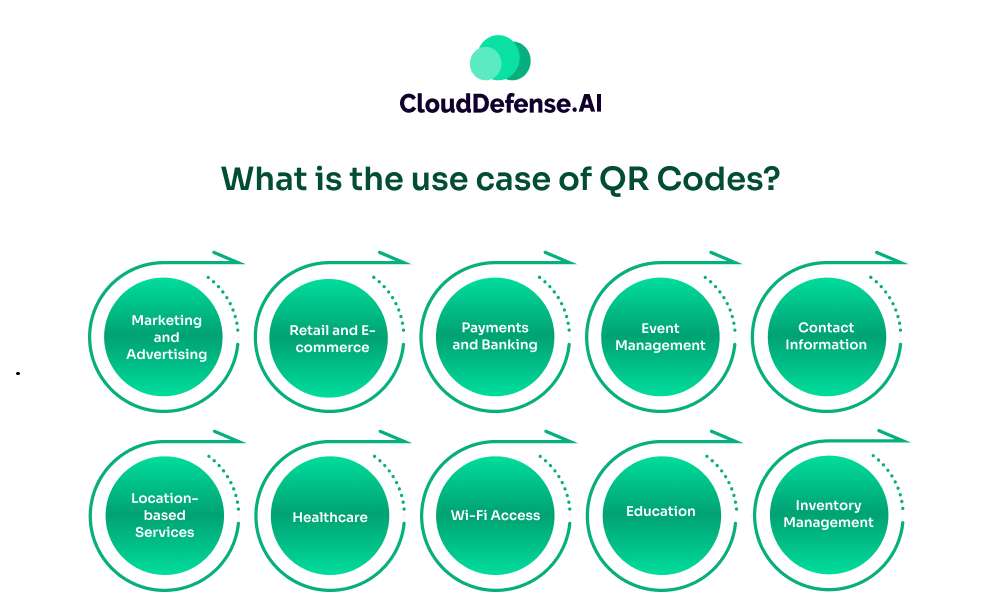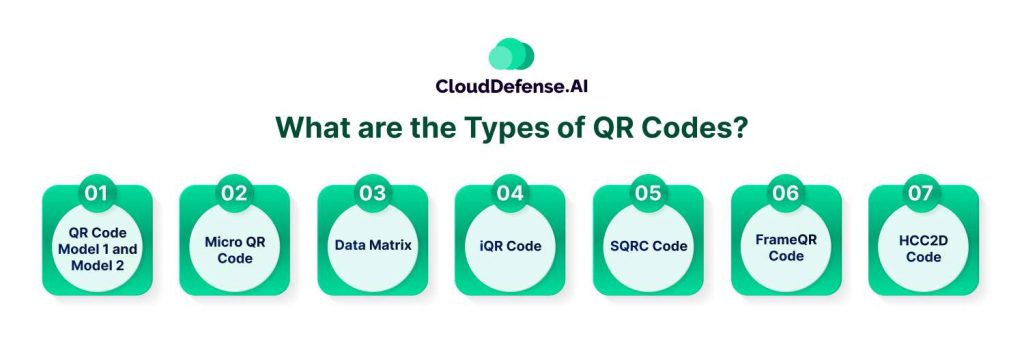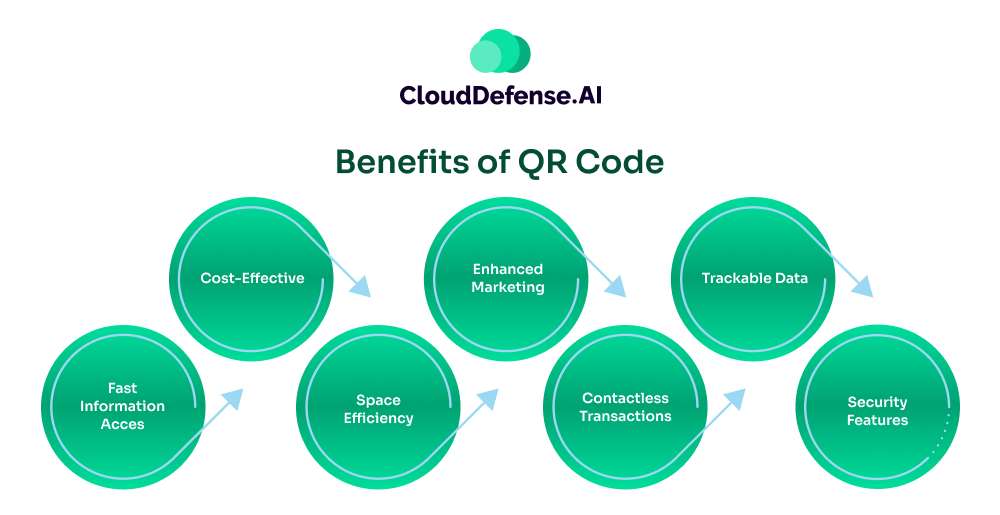What are QR Codes?
A Quick Response, or QR, code is a type of barcode that appears as a square pattern and is used to store encoded data. It functions as a data storage medium, similar to a thumb drive, and is utilized to create digital marketing entities on physical objects, enabling rapid mobile web services.
When scanned with a QR code reader, the encoded content becomes immediately accessible, triggering actions such as opening a specific URL in the user’s web browser, checking in to a location, or connecting to a wireless network.
QR codes primarily store ASCII text, but they are also capable of storing binary code. This versatility allows QR codes to perform a wide range of functions, making them a popular tool in various applications.
How do QR Codes work?
QR codes work by encoding information, such as URLs, text, or binary data, into a pattern of black and white squares using a QR code generator. Each square in the pattern represents a specific piece of data.
When a user scans the QR code with a reader, typically a smartphone camera equipped with a QR scanning app, the reader captures the pattern and uses an algorithm to decode it, extracting the encoded information.
This data extraction process is quick and efficient due to the high contrast and unique arrangement of the squares. Once the data is decoded, it triggers a predefined action, such as opening a web page, checking in at a location, sending an email, or connecting to a Wi-Fi network, providing users with immediate access to the intended content or service.
What is the use case of QR Codes?

QR codes have a wide range of applications due to their versatility and ease of use. Some common use cases have been mentioned below.
- Marketing and Advertising: QR codes on posters, flyers, magazines, and billboards allow users to quickly access websites, promotional videos, or special offers.
- Retail and E-commerce: QR codes on product packaging can provide detailed information, user manuals, or discount codes, enhancing customer engagement and convenience.
- Payments and Banking: Many mobile payment systems use QR codes to facilitate quick and secure transactions by scanning the code to transfer funds or complete purchases.
- Event Management: QR codes on tickets or passes streamline check-ins and entry processes at events, reducing wait times and improving security.
- Contact Information: Business cards with QR codes can instantly share contact details, websites, or social media profiles when scanned.
- Location-based Services: QR codes in public places like museums, parks, or city attractions provide visitors with additional information, guides, or interactive experiences.
- Healthcare: QR codes on medical records, prescriptions, or hospital wristbands ensure quick access to patient information and enhance the efficiency of medical services.
- Wi-Fi Access: QR codes can be used to share Wi-Fi credentials, allowing users to connect to a network by simply scanning the code.
- Education: Teachers and educational institutions use QR codes to provide students with additional resources, assignments, or multimedia content.
- Inventory Management: QR codes on products or storage containers help businesses track inventory, manage stock levels, and streamline logistics operations.
What are the Types of QR Codes?

QR codes are used for various purposes, and different types are created to perform specific actions through smartphones. Here are the common types of QR codes.
QR Code Model 1 and Model 2
These are the standard QR codes seen in cafes, shops, and magazines for marketing purposes. They can encode data for Google Maps locations, image galleries, PDFs, URLs, and vCards. Model 1 QR codes can store up to 1,167 numerals, while Model 2 can store up to 7,089.
Micro QR Code
Featuring only one position detection pattern, Micro QR codes are designed for small surfaces, such as food packaging. They can encode letters or numbers up to 2,335 characters in length.
Data Matrix
This type of QR code can encode text or numeric data up to 1,556 bytes and 2,335 characters in length. Data Matrix codes are often used in various industries for tracking and identification.
iQR Code
iQR codes can be either square or rectangular and printed in different patterns, such as dot pattern, inversion, or turned-over code. They have a high storage capacity, capable of storing up to 40,000 numerals.
SQRC Code
Similar in appearance to regular QR codes, SQRC codes are used for storing confidential information due to their restricted access.
FrameQR Code
These QR codes feature a frame area that can store images and letters, making them ideal for promotional activities and branding.
HCC2D Code
The High-Capacity Colored 2-Dimensional code is a proposed format that increases data density and enables QR codes to handle chromatic distortions, allowing for more complex and colorful designs.
Benefits of QR Code

QR codes offer numerous advantages across various industries due to their versatility, convenience, and efficiency. Here are some key benefits:
- Fast Information Access: Scanning a QR code provides immediate access to the encoded information, such as URLs, contact details, or multimedia content, facilitating quick and efficient information retrieval.
- Cost-Effective: Generating and printing QR codes is inexpensive, making them a cost-effective tool for businesses and marketers to share information and promote products or services.
- Space Efficiency: QR codes can store a large amount of information in a small space, making them ideal for use on small surfaces like business cards, packaging, and promotional materials.
- Enhanced Marketing: By integrating QR codes into marketing campaigns, businesses can provide customers with easy access to websites, special offers, and detailed product information, improving customer engagement and conversion rates.
- Contactless Transactions: QR codes facilitate contactless transactions, such as mobile payments and ticketing, promoting hygiene and convenience, especially in a post-pandemic world.
- Trackable Data: Businesses can track QR code scans to gather valuable data on user behavior and campaign performance, helping to refine marketing strategies and improve targeting.
- Security Features: While there are risks, QR codes can also enhance security by enabling encrypted data storage and secure transactions, particularly when used with appropriate security measures.
Are QR Codes Safe?
QR codes, while highly convenient, can pose significant security risks if misused. Attackers can embed malicious URLs into QR codes that, when scanned, direct users to websites containing custom malware designed to exfiltrate data from their mobile devices. Additionally, malicious URLs can lead to phishing sites where unsuspecting users may disclose personal or financial information.
The inherent challenge with QR codes is that their content is not human-readable, making it easy for attackers to alter QR codes to point to alternative, harmful resources without detection. While many users understand that scanning a QR code can open a URL, they may be less aware of other actions that QR codes can initiate, such as adding contacts or composing emails. This lack of awareness can make QR code security threats particularly problematic.
A common attack involves placing malicious codes in public places, sometimes covering legitimate QR codes. When unsuspecting users scan these codes, they may be taken to a malicious web page hosting an exploit kit, leading to device compromise, or to a spoofed login page designed to steal user credentials. Some malicious websites perform drive-by downloads, where simply visiting the site initiates a malware download.
Moreover, mobile devices are generally less secure than computers or laptops, increasing the potential risks associated with QR code usage on these devices. To mitigate these risks, users should exercise caution when scanning QR codes, ensure their mobile devices are equipped with security software, and avoid scanning codes from untrusted sources.
How to Protect yourself from Unsafe QR Codes?
Protecting against unsafe QR codes is possible. You can do so by using trusted QR code scanning apps, preferably built-in ones on your device. Always preview the URL before opening, ensuring it starts with “https://” for a secure connection.
Be cautious of shortened URLs, which can obscure the final destination; use online URL expanders to verify them. Only scan QR codes from trusted sources, such as official websites, reputable companies, or known contacts, and avoid scanning random codes found in public places, especially if they appear tampered with.
These precautions can help protect against malware, phishing attempts, and other malicious activities that hackers carry out.
Final Words
QR codes are versatile tools that bridge the physical and digital worlds, allowing quick access to information through a simple scan. Their uses range from marketing and payments to health and education, demonstrating their broad applicability.
However, with their convenience comes the need for vigilance against potential security risks. By understanding how QR codes work and adopting safe scanning practices, users can fully leverage their benefits while minimizing potential threats.







